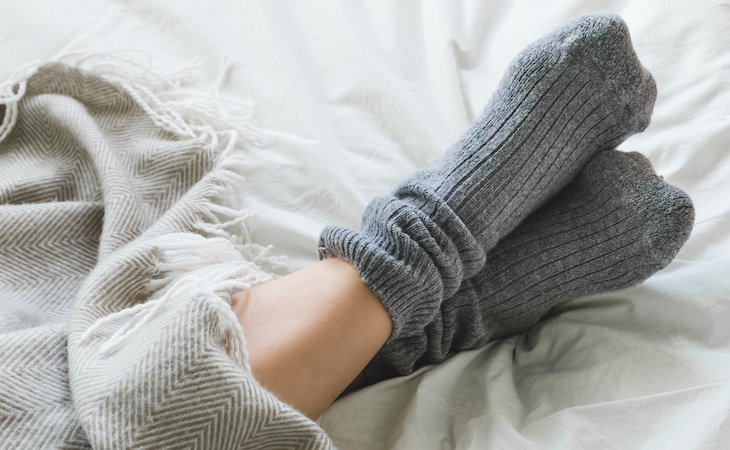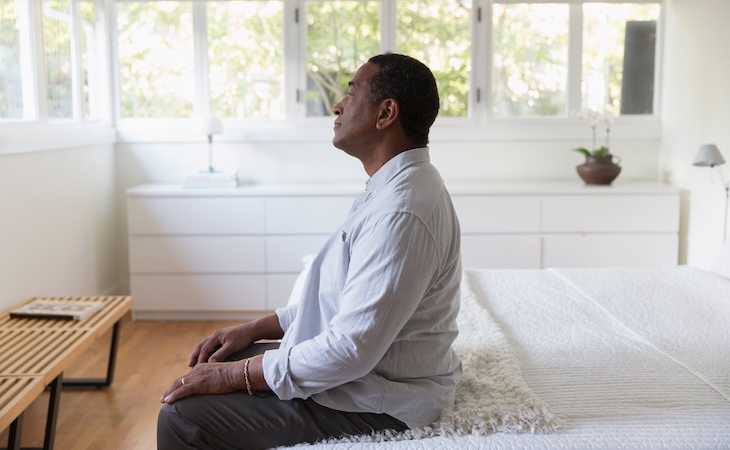While there could be many reasons why you’re not getting the amount of shuteye you need, just know that you’re not alone. In fact, in our recent survey of 2,000 Americans, we found that three in five people have trouble falling asleep, with anxiety being the most significant cause. [1]
The survey mentioned that half of the study participants had dreams related to stress, and over 40% said next-day anxiety is the cause of their sleeplessness—which suggests that stress and anxiety need to be controlled for sleep quality to be improved.
Most recently, a viral sleep trend on TikTok promises to help you do just that. With over 79.6 billion views on the app, “cricket feet” swears to help calm your nervous system, reduce stress, and make it just that much easier to fall asleep. But what exactly is it—and how does it work?
We spoke to Kristina Grabnickas, a certified sleep coach and nurse practitioner who works at Lake Nona Wave Hotel as their resident sleep expert, to find out all about this viral trend and whether you should be incorporating it into your nighttime routine.
What is cricket feet?
“There are some things you may already be doing to relax your body before you fall asleep (such as avoiding blue light from devices or having a warm cup of tea), but there’s another soothing habit that has people on TikTok asking, ‘Where are my fellow crickets?’” says Grabnickas. “Cricket feet, or cricketing, is simply the habit of rubbing one foot against the other repeatedly, in an effort to soothe yourself to sleep.”
Cricket feet, or cricketing, is simply the habit of rubbing one foot against the other repeatedly, in an effort to soothe yourself to sleep.
Kristina Grabnickas, resident sleep expert at Lake Nona Wave Hotel
This behavior is named after the insect. The cricket does the same thing to make its signature chirping sound. So, cricket feet refers to the physical movement of rubbing one’s feet together—it’s just for humans. And it turns out that a ton of us are doing it, which explains why it’s all over the internet right now.
Why do I rub my feet together—or cricket—in bed?
“You may not realize it while you’re doing it, but cricketing is a way that you can help calm your nervous system before bed,” says Grabnickas. “It’s a type of motor function, also known as a repetitive, rhythmic movement with a predictable pattern.” [2]
According to Grabnickas, most people do it subconsciously. In the psych world, the behavior is called stimming. Most children do some sort of repetitive movement, such as twirling their hair, humming, or (you guessed it) rubbing their feet together, to help calm themselves. This behavior often extends to adulthood as well. [2]
It’s also important to note that research has found a link between stimming and developmental disorders like autism and ADHD, suggesting that those with these conditions could use stimming to soothe or communicate emotions. [3]
“Cricketing is a type of stimming, but if you cricket, that doesn’t necessarily mean you have ADHD or any other kind of developmental disorder,” explains Grabnickas. “Most people use it as a soothing technique before bed—but if you do it throughout the day to better focus on the task you have at hand, it may be a sign of something else.” [2]
If you simply cricket because you find it helps calm you down before bed, that’s not a sign to be worried, she adds.
Can rubbing your feet together in bed help you fall asleep?
While there’s no direct research linking cricket feet to better sleep, there could be many reasons why the movement is so soothing to people.
For one, there are several acupressure points on your feet, and rubbing them together may promote relaxation by targeting those points.[4] Research has suggested that—similar to a gentle foot massage—cricketing can be a form of reflexology that will help you go to sleep faster. [4]
Additionally, the repetitive motion of cricketing could help you simply be happier. Studies have shown that these kinds of repeated movements release oxytocin in the body. [5] Oxytocin is a hormone associated with decreased stress and increased joy.[6]
“This is because cricketing (and similar repeated movements) can help stimulate the parasympathetic nervous system, which is known for controlling the body’s relax response,” says Grabnickas. [7] That means cricketing could potentially help calm you down when you need it.
Still, it’s worth noting that cricketing may not be effective on everyone and that most do it as a form of subconscious behavior. So, if you don’t feel the need to cricket, don’t worry about it.
However, if you find your to-do list often keeps you awake at night, then you may want to give the motion a try, says Grabnickas.
Are there any downsides to cricketing?
“Overall, there are no downsides associated with cricketing yourself to sleep,” says Grabnickas. “However, some people may find the movement bothersome (especially partners of those who cricket), while others may not be able to control the urge to do it.”
In that case, you may have something else going on, such as restless leg syndrome, which is also often associated with ADHD, explains Grabnickas. [8]
Therefore, if you’ve just started cricketing, then it’s important to look at the reason behind why you do so. If it’s to help you sleep after a particularly stressful day, then there’s nothing to worry about.
However, if you’re doing it compulsively or can’t fall asleep without doing so, then there may be other issues going on. It’s important to discuss this with a doctor or therapist. They may be able to pinpoint an underlying condition or give you better coping mechanisms for your stress.
FAQs
Why do people rub their feet together before falling asleep?
Most people rub their feet together before bed because they find it soothing, which may make it easier for them to fall asleep. The repeated motion of cricketing can help stimulate the parasympathetic nervous system and bring about a relaxed feeling in the body.[7] Also, activating the nerve endings on the feet while cricketing could act as a form of reflexology. [4]
Is rubbing your feet together a sign of ADHD?
Rubbing your feet together, or cricketing, can be a stimming behavior, which research has linked to ADHD. [3, 9] However, simply partaking in cricketing behavior isn’t necessarily a sign of ADHD unless it’s also accompanied by other symptoms such as hyperactivity, impulsiveness, and inattention. Those with ADHD who partake in cricketing also are more likely to do it throughout the day as an effort to focus as opposed to simply choosing it as a self-soothing technique before bed.
What else can help calm you before bed? Check out our list of the best nighttime activities to help you relax.
References
- Saatva. Survey Says This Is What Keeps Americans Up at Night. https://www.saatva.com/blog/up-all-night-survey/
- Cleveland Clinic. What Is Stimming? https://health.clevelandclinic.org/what-is-stimming
- Sokolova, E., Oerlemans, A. M., Rommelse, N. N., Groot, P., Hartman, C. A., Glennon, J. C., Claassen, T., Heskes, T., & Buitelaar, J. K. (2017). A Causal and Mediation Analysis of the Comorbidity Between Attention Deficit Hyperactivity Disorder (ADHD) and Autism Spectrum Disorder (ASD). Journal of autism and developmental disorders, 47(6), 1595–1604. https://doi.org/10.1007/s10803-017-3083-7
- Cai, D. C., Chen, C. Y., & Lo, T. Y. (2022). Foot Reflexology: Recent Research Trends and Prospects. Healthcare (Basel, Switzerland), 11(1), 9. https://doi.org/10.3390/healthcare11010009
- Uvnäs-Moberg, K., Handlin, L., & Petersson, M. (2015). Self-soothing behaviors with particular reference to oxytocin release induced by non-noxious sensory stimulation. Frontiers in psychology, 5, 1529. https://doi.org/10.3389/fpsyg.2014.01529
- Harvard Health. Oxytocin: The love hormone. https://www.health.harvard.edu/mind-and-mood/oxytocin-the-love-hormone
- Cleveland Clinic. Parasympathetic Nervous System (PSNS). https://my.clevelandclinic.org/health/body/23266-parasympathetic-nervous-system-psns
- Migueis, D. P., Lopes, M. C., Casella, E., Soares, P. V., Soster, L., & Spruyt, K. (2023). Attention deficit hyperactivity disorder and restless leg syndrome across the lifespan: A systematic review and meta-analysis. Sleep medicine reviews, 69, 101770. https://doi.org/10.1016/j.smrv.2023.101770
- Attention Deficit Disorder Association. ADHD Stimming: Why It Happens And How To Cope. https://add.org/stimming-adhd/




